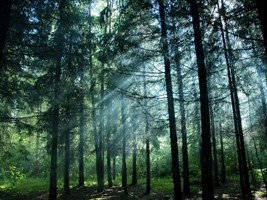 89,1 % of the Reserve's total area is covered with forests. Stretching widthwise to make a single tract, they fully reflect the natural qualities of a southern taiga forest. More than half of the forests are coniferous trees, basically spruce and pine. Particularly common here are pine groves with an emerald–like moss carpet and a variety of bilberry, blueberry and heather shrubs. The soil humidity and fertility increase at lower lands and there is more spruce in the pine stands. Especially rare are the virgin leaf forests at fens. Their characteristic feature is that one comes across several generations of black alder at a time. Next to thick, sturdy trunks of maternal canopy there is a variety of young trees of different age. Once an old tree falls, one or two young shoots immediately come out reaching for the n. In this way, the forest is ever growing.
89,1 % of the Reserve's total area is covered with forests. Stretching widthwise to make a single tract, they fully reflect the natural qualities of a southern taiga forest. More than half of the forests are coniferous trees, basically spruce and pine. Particularly common here are pine groves with an emerald–like moss carpet and a variety of bilberry, blueberry and heather shrubs. The soil humidity and fertility increase at lower lands and there is more spruce in the pine stands. Especially rare are the virgin leaf forests at fens. Their characteristic feature is that one comes across several generations of black alder at a time. Next to thick, sturdy trunks of maternal canopy there is a variety of young trees of different age. Once an old tree falls, one or two young shoots immediately come out reaching for the n. In this way, the forest is ever growing.
Boreal coniferous pine and spruce forests are the most widely spread in the reserve, i.e. 53,1 % of the wooded area. Pine woods occupy 33,6 ths ha and form vst tracts in the northern and central parts of the reserve. Monodominant pine woods growing on sandy hardly moisted soils are localized in the elements of the dune-hilly landscape and are characterized by poor floristic composition. Spruce-pine wods on half hydromorphic turf-podzol soils are of greater specific diversity an a distinct layer of spruce undergrowth. Spruce woods cover the area of 6,7 ths ha, do not form vast tracts and are mainly locates along the Berezina and on the edges of fens. Typical taiga bilberry-greenmossy and longmossy spruce woods are characterized by a monodominant arboreous layer, thick mossy and shrubbery land-cover. The broad-leaved-spruce, or nemoral spruce, forests are characterized by the ash, oak, lime, maple admixture in the tree-stand and by the presence of nemoral elements in the undergrowth and land-cover.

The total area of broad-leaved forests in the reserve is 0.7 %. They are represented by the oak and ash phytocenoses. The oak woods area totals about 300 ha, and almost all of them are located in the ancient flood-lands of the Berezina. The oak woods occupy slightly raised areas with drained, humus-glayish soils. The tree-stand is well-closed, with the spruce, ash, pine, warty birch admixture, of III bonitation, the wood supply at the age of 140 to 160 is 250 to 380 cbm/ha. The area of ash woods totals 250 ha. They are mainly concentrated on the right swamped bank of the Berezina near Lake Palik, where they form a complex spruce-blackalderash formation on the rich humus-glay soils. The vegetation is characterized by the presence of a complex of boreal south-taiga nemoral and mire elements. The tree-stand is of II class of bonitation, the wood supply reaches from 250 to 330 cbm/ha.
Small-leaved forests are presented by primary deciduous marshy forests and secondary small-leaved forests. Deciduous marshy forests cover 35,6 % of the wooded area and are represented by two aboriginal formations of the black-alder (15,8 %) and pubescent-birch (18,4 %) forests, forming in eutrophic and mesotrophic mires. The black-alder woods form the largest tract in the plain southern part of the Reserve. They are characterized by a high level of intactness and are of the unique value as a natural model object. Natural admixture in the arboreous layer of the black-alder woods is formed by the pubescent birch, spruce, and in ecotones adjacent to mineral islands - by ash, oak and maple. Live land-cover is characterized by the diversity of hygrophytes belonging to the elements of the nanorelief. The pubescent-birch woods in the reserve represent all the diversity of aboriginal birch forests characteristic of the subzone of broad-leaved and spruce forests.
Fourteen forest type complexes being a taxon of the territory nature regioning have been identified in the Reserve. They are regarded as spatial units with consistent patterns of forest types combination on the basis of certain landscape elements conjugation with diverse soil. Typological forest complexes are characterized on the basis of a number of structural indications including aboriginal forest formations, vegetation successions, swamping processes, belonging to geomorphological structurs, density and size of forest tracts, correlation of woodless lands.